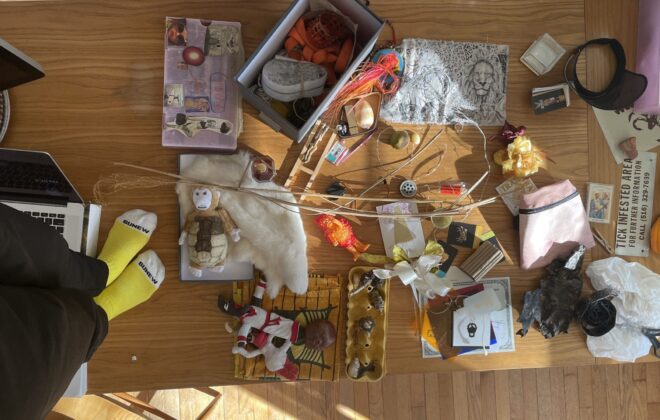Week 12 – Interface refinement and presentation feedback
Switching to a dat.gui and recording an intro
Based on the user testing that I had done, I opted to simplify my interface design for the moment by using a dat.gui interface for all of the controls that could live off to the right side of the screen. Though the mapping between appearance and possible action is not quite as intuitive this way, it allowed me to focus on refining the control elements that I wanted to have accessible.
Through my own use and one more round of user testing with somebody, I found that the dat.gui interface seems very usable once you have a sense of what everything does but frontloading a little bit of an explanation can really help orient somebody to what is going on. So I decided to record a short overview of the tool and how it works that I could both show during the class presentation and use in user testing as a starting point for figuring out the different options for explaining what things do and how the algorithm works. The resulting video is about 5 minutes:
Final presentation to class
For our final presentation to the class I structured my talk around the following framework as recommended by Andrew:
- Opening
- Show Us Who You Are
- Frame Your Thesis
- Share Your Process
- Show your work
- What’s Next?
- Say Thank You
The slides and my notes can be found here:
Subdivisio! Final Presentation slides
I found the framework very useful for being able to both lay out the story behind my thesis project and how it connects to me as well as the major influences on it.
I received some encouraging and helpful feedback from the presentation. The main comments were as follows:
- “The Institute for Figuring” from Margaret Wertheim might be a possible connection or outlet
- Nice job telling the story and developing rapport within the presentation
- Curious about how a connection to Islamic geometry might be incorporated
- Wondering if it was designed to serve students or a broader audience
- Recommended focusing on a toolbox or reference material to help strengthen and support the connection between the artistic object and the mathematics behind the process
- Images of the output were very compelling and might feature more prominently in a presentation
After looking it up, I realized that I was familiar with Margaret Wertheim’s work exploring the mathematics of surfaces by crocheting coral reefs. A project whose TED talk I really love and has been influential on my interest in natural systems and computational and mathematical thinking.
I also found this really nice essay on Froebel’s invention of kindergarten on the website which provided a little more context to some of the initial research I had started to do into his gifts. I think it is very interesting how influential the objects in his gifts were in developing the aesthetics and providing a conceptual foundation for some major 20th century artists.
Islamic geometry is certainly something that I had already planned on pointing to in some way in my windows and doors section of the page, I’m not sure that I would want to explicitly tie it into the experience itself more directly.
I definitely agree that one of the major things to work on in the Summer session is to develop the tools and interactions that can help to provide some useful visualizations and explanations of what is happening within the subdivision algorithm. But I think there is an important balance to strike between providing the opportunity for delving deeper but not becoming overly pedantic in a way that overshadows the tinkering and exploratory aspects of the experience.
Related Posts
1 Comment
Leave a Reply Cancel reply
You must be logged in to post a comment.
Kat Sullivan
Adam Colestock
Helen (Chenuan) Wu
Christina Lan
Dorian Janezic
George Faya
Julia Myers
Kelsie Smith
Michael Morran
Po-Wen Shih
Liu Siyan
Fisher Yu
—
Craig Protzel
Christopher Wray
Haoqi Xia
Hayden Carey
Katherine Nicoleta Helén
Maria Maciak
Parisa Shemshaki
Sakar Pudasaini
Skyler Pierce
Steven Doughty
Yiqi Wang
—
Andrew Lazarow
Benoit Belsot
Enrique García Alcalá
Hongyi Zhang
Jay Mollica
Li Shu
Teddy (Jian) Guo
Monika Lin
Wenye Xie
Yiru Lu


one thing I noticed with successful Youtube tech tutorials, is that they show you a more final product at the beginning to give the audience a sense of where they’re going, and then jump into onboarding. may be something worth considering here
Also it would be great if this included captioning!